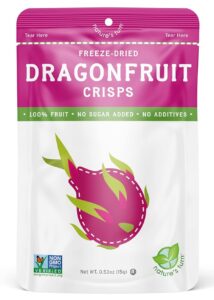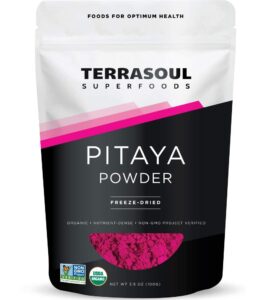Pitaya Superfruit – Dragon Fruit Benefits
A guest post by Joe.ph
Dragon Fruit Benefits Face-Off: How It Beats Other Superfruits

You’ve probably seen dragon fruit’s striking pink exterior and polka-dotted white flesh flooding social media feeds. But this photogenic fruit offers far more than visual appeal. At just 60 calories per 100 grams, dragon fruit delivers serious nutritional value without the caloric cost of many other superfruits. Vietnam produces over 1,000,000 metric tons annually, proving this exotic fruit has moved well beyond trendy novelty status.
The numbers tell an interesting story. One cup gives you 5.6 grams of fiber for only 103 calories – better than blueberries when you factor in the lower carb content. Dragon fruit also brings antioxidants like betalains and flavonoids, plus essential nutrients including Vitamin C, iron, and magnesium.
Here’s what caught my attention: dragon fruit often outperforms the superfruits that get all the spotlight. Blueberries might dominate the health food conversations, but dragon fruit matches many of their benefits while keeping calories lower. Add in unique prebiotics that actually feed your gut bacteria, and you start to see why this fruit deserves serious consideration.
We’re going to put dragon fruit head-to-head with other celebrated superfruits across key health benefits – antioxidant strength, blood sugar impact, heart health support, and more. What you’ll discover might change which fruits make it into your weekly shopping cart.
Antioxidant Power: Dragon Fruit vs Blueberries vs Acai
Antioxidants work like tiny shields in your body, blocking damage from free radicals that can age your cells and cause disease. Each superfruit brings its own arsenal to this fight, but they don’t all work the same way.
Vitamin C Content: 3mg vs 9.7mg vs 8mg
Let’s start with vitamin C since most people recognize this one. Blueberries win this round with approximately 9.7mg per 100g, while acai comes in at around 8mg, and dragon fruit sits at roughly 3mg. Dragon fruit clearly loses the vitamin C battle.
But that’s not the whole story. Dragon fruit compensates with other powerful antioxidants you won’t find in most fruits. Plus, vitamin C teams up with these unique compounds to boost the overall antioxidant punch.
Betalains vs Anthocyanins vs Polyphenols
This gets interesting because each fruit uses completely different chemical weapons:
Dragon fruit’s secret weapon? Betalains – nitrogen-containing pigments that create those vibrant pink and red colors. You get betacyanins (the red-violet ones) and betaxanthins (yellow-orange ones). These compounds excel at donating electrons to neutralize free radicals. The betalamic acid in betalains scores a Trolox equivalent antioxidant capacity (TEAC) value of 2.7, matching resveratrol’s power.
Blueberries and acai take a different approach with anthocyanins – the compounds behind their deep purple-blue colors. Acai packs cyanidin-3-glucoside (4.94 mg/100g) and cyanidin-3-rutinoside (17.9 mg/100g). These molecules attack free radicals through their phenolic hydroxyl groups.
Acai doesn’t stop there. It also loads up on proanthocyanidins and other flavonoids, creating the diverse antioxidant profile that earned its “superfood” reputation.
 Free Radical Neutralization Capacity
Free Radical Neutralization Capacity
Scientists use the ORAC (Oxygen Radical Absorbance Capacity) scale to measure how well foods actually neutralize free radicals. Think of it as a combat effectiveness rating.
Acai dominates with an ORAC value of 18,400, crushing blueberries at 3,200. Dragon fruit scores lower than both, but here’s the twist – its betalains work through completely different mechanisms.
Real-world studies show acai’s effectiveness. People who consumed acai pulp tripled their blood’s antioxidant activity within 24 hours. That’s not just laboratory theory – that’s measurable protection happening in actual human bodies.
Dragon fruit’s betalains operate differently. Betacyanins outperform betaxanthins as antioxidants because they can more easily give up electrons from their phenolic oxygen atoms, creating stable radicals that won’t cause further damage.
Dragon fruit might not top the ORAC charts, but its betalains offer something unique. Research shows they specifically protect against hydrogen peroxide damage – the kind your cells face daily. Sometimes it’s not about having the highest numbers; it’s about having the right tools for specific jobs.
Digestive Health: Fiber and Prebiotics Compared
Your gut health determines how well your body absorbs nutrients, fights off harmful bacteria, and even influences your mood. Dragon fruit delivers digestive benefits that go well beyond what most superfruits can offer.
Fiber Content: 3g vs 2g vs 2.5g per 100g
Dragon fruit takes the lead with 3 grams of fiber per 100-gram serving, outpacing both acai berries at 2.5 grams and blueberries at just 2 grams per 100 grams.
 This fiber advantage translates into real digestive benefits. One cup of dragon fruit covers roughly 20% of your daily fiber needs, which means:
This fiber advantage translates into real digestive benefits. One cup of dragon fruit covers roughly 20% of your daily fiber needs, which means:
- Better bowel regularity
- Smoother digestive movement
- Longer-lasting satiety with fewer calories
- More fuel for beneficial gut bacteria
Dragon fruit’s high fiber content directly supports bowel regularity, helping your body efficiently eliminate toxins and waste.
Prebiotic Effects: Dragon Fruit’s Oligosaccharides vs Others
Most fruits provide basic fiber, but dragon fruit contains specialized prebiotic compounds called oligosaccharides. These unique compounds resist breakdown by human enzymes, allowing them to reach your colon intact.
Once they arrive, dragon fruit oligosaccharides (DFO) become premium food for beneficial gut bacteria. Unlike other prebiotics that may break down too early, DFO survives stomach acid and digestive enzymes, ensuring maximum gut benefit.
Clinical research reveals impressive results: DFO at 8g daily significantly promoted the growth of beneficial Bifidobacterium (up 8.41%) and Faecalibacterium (up 1.99%) while reducing harmful Escherichia coli by 8.44%. This selective bacterial support gives dragon fruit a distinct advantage over other superfruits.
DFO also speeds up gut transit time, helping food move more efficiently through your system. Studies show increased fecal output compared to control groups, potentially helping those with sluggish digestion.
Gut Microbiome Support: Lactobacilli Growth
Dragon fruit specifically boosts Lactobacilli growth, and these bacteria serve as direct communicators with your gut lining to:
- Maintain gut barrier integrity
- Support mucosal defense
- Improve immune responses
Healthy Lactobacilli levels produce short-chain fatty acids (SCFAs) like butyrate, acetate, and propionate by fermenting dragon fruit’s fiber and prebiotics. These SCFAs:
- Fuel colon cells
- Maintain optimal gut pH
- Prevent harmful bacterial overgrowth
Dragon fruit oligosaccharides actively stimulate growth of both lactobacilli and bifidobacteria. This matters because these bacteria help regulate both adaptive and innate immune responses.
Other superfruits offer general fiber benefits, but dragon fruit’s oligosaccharides specifically promote lactobacilli and bifidobacteria growth, providing more targeted gut health support.
Dragon fruit’s combination of higher fiber content and specialized prebiotic compounds makes it particularly valuable for digestive health improvement.
Heart Health Benefits: Cholesterol and Blood Pressure Effects
Your heart doesn’t care about superfood trends – it responds to measurable improvements in cholesterol, blood pressure, and inflammation markers. Dragon fruit delivers on all three fronts, often outperforming fruits with bigger reputations.
LDL Reduction: Dragon Fruit vs Cherries vs Avocado
Dragon fruit consumption reduces total cholesterol, LDL (bad) cholesterol, and triglycerides while boosting HDL (good) cholesterol levels. That’s a complete lipid profile makeover from one fruit.
Avocado brings monounsaturated fats that tackle LDL cholesterol effectively. The oleic acid helps reduce inflammation and fatty liver while increasing beneficial fats. Cherries offer anthocyanins for heart support, though their cholesterol impact lacks the extensive research backing the other two.
Animal studies reveal dragon fruit’s impressive reach. Rats eating red dragon fruit saw their triglycerides, total cholesterol, and LDL levels drop significantly while HDL climbed. Dragon fruit may also prevent LDL oxidation – critical because oxidized LDL does the most arterial damage.
Potassium Levels: 300mg+ in Dragon Fruit vs Others
 Dragon fruit packs approximately 468mg of potassium per 100g serving – that’s 13% of your daily needs in one portion. This mineral works behind the scenes to:
Dragon fruit packs approximately 468mg of potassium per 100g serving – that’s 13% of your daily needs in one portion. This mineral works behind the scenes to:
- Balance fluids throughout your body
- Keep nerves and muscles functioning properly
- Counter sodium’s blood pressure effects
Adequate potassium intake neutralizes sodium’s harmful effects, potentially lowering blood pressure in hypertensive individuals. Potassium also supports muscle function, including your heart muscle, reducing cramps and weakness.
Anti-inflammatory Compounds and Cardiovascular Impact
Dragon fruit’s betalains – those vibrant red-violet pigments – significantly reduce total cholesterol, LDL, and other heart disease markers. Chronic inflammation drives lipid metabolism problems and heart disease, but dragon fruit’s anti-inflammatory properties influence these pathways and improve lipid profiles.
The high fiber content adds another layer of protection by helping eliminate bile acids and reducing dietary fat absorption. This multi-pronged approach makes dragon fruit particularly effective for cardiovascular wellness.
Combined with its antioxidant properties, dragon fruit shows potential for improving arterial stiffness, reducing blood pressure, and controlling pulse wave velocities – key cardiovascular health indicators that actually matter for long-term heart function.
Blood Sugar and Weight Management: Low-GI Superfruits Face-Off
Sweet cravings don’t have to derail blood sugar goals. The right fruit choices can actually support both glucose control and weight management – you just need to know which ones deliver the best results.
Glycemic Index: Dragon Fruit vs Mango vs Banana
Glycemic index measures how quickly foods spike blood sugar. Anything under 55 counts as low-GI territory, where you want to stay for steady energy.
Dragon fruit scores 48-52 on the glycemic index, putting it squarely in the safe zone. Mango and banana both clock in around 51, seeming comparable at first glance. But the total carbohydrate picture tells a different story.
Dragon fruit contains just 13 grams of carbs per 100 grams, while banana packs 23 grams and mango delivers 15 grams. This difference matters significantly for anyone tracking blood glucose responses. Lower total carbs plus low GI equals gentler impact on blood sugar levels.
Satiety and Calorie Density: 59 kcal vs 90+ kcal
Successful weight management comes down to feeling satisfied with fewer calories. Dragon fruit excels here where many tropical fruits fall short.
At 59 calories per 100 grams, dragon fruit beats passion fruit’s 97 calories and mango’s 90 calories by a wide margin. The secret lies in its composition: high fiber content (3g per 100g) combined with substantial water content creates genuine satiety without caloric overload.
This combination hits the sweet spot for weight management – literally satisfying sugar cravings while supporting calorie control goals.
Insulin Sensitivity Improvements in Studies
Beyond favorable glycemic numbers, dragon fruit shows potential for actually improving how your body handles sugar.
Animal research reveals both red and white dragon fruit varieties reduced insulin resistance and fatty liver in obese mice. One particular study found mice given dragon fruit extract gained less weight while showing better liver fat profiles and insulin sensitivity.
The most fascinating research suggests dragon fruit might help regenerate damaged pancreatic cells – the very cells responsible for insulin production. This could explain why some studies show improved insulin sensitivity and lower fasting glucose after dragon fruit consumption.
Human studies echo these promising findings. Participants at risk for type 2 diabetes showed reduced insulin responses after four weeks of consuming frozen red dragon fruit beverages. Separate research on prediabetic individuals found significant drops in fasting plasma glucose levels.
The research remains somewhat inconsistent across human studies, indicating more investigation is needed. Still, the current evidence suggests dragon fruit offers blood sugar benefits beyond what its glycemic index alone might predict.
 Nutrient Density and Versatility: Which Superfruit Wins?
Nutrient Density and Versatility: Which Superfruit Wins?
Time to step back and look at the bigger picture. How do these superfruits actually stack up when you consider the complete package – nutrition, practicality, and how they fit into real life?
Dragon Fruit Nutrition Facts vs Blueberries vs Acai
The calorie story gets interesting when you compare the full profiles. Dragon fruit delivers 57-60 calories per 100g serving – notably less than acai’s 73 calories and blueberries’ 84 calories. But the carb breakdown tells a different story: dragon fruit provides 15g carbs with 3g fiber, while acai keeps it low at 4.8g carbs and 3g fiber. Blueberries pack more carbs with less fiber density.
Fat content varies dramatically too. Dragon fruit stays minimal at 0.14g, while acai brings 6g of healthy fats – making acai better for those seeking fat-soluble vitamin absorption.
Vitamin and Mineral Spectrum
Each fruit brings its own micronutrient strengths to the table. Dragon fruit delivers vitamin C, magnesium, iron, and that impressive 468mg of potassium per serving, plus bone-supporting calcium. Blueberries counter with vitamins C, K, and manganese. Acai rounds out the group with 40mg calcium and 1.08mg iron.
The takeaway? No single superfruit covers all bases – they complement each other.
Culinary Uses: Smoothies, Salads, Bowls
Where dragon fruit really wins is versatility. This fruit adapts to almost anything:
- Smoothies and bowls – Blend with coconut milk for tropical flavor
- Fruit or green salads – Pair with avocado, feta, and citrus dressing
- Refreshing sorbets – Puree with lime juice for a vibrant dessert
- Tropical salsas – Mix with cucumber, onion, and jalapeño
What started in South American kitchens now appears on menus worldwide. The mild flavor means it won’t overpower other ingredients, while that striking appearance makes any dish Instagram-ready. Try finding another superfruit that works equally well in savory salsas and sweet desserts.
Conclusion
Dragon fruit has earned its place among superfruits, but not for the reasons you might expect. While other fruits dominate specific categories – acai wins the antioxidant race, blueberries pack more vitamin C – dragon fruit delivers something different: balanced nutrition that actually fits into your daily life.
The digestive health story tells you everything. Those 3g of fiber per 100g and specialized oligosaccharides work together to feed your gut bacteria in ways most fruits can’t match. Your Lactobacilli and Bifidobacteria get exactly what they need to thrive, which matters more than you might think for overall health.
Heart health follows the same pattern. Dragon fruit doesn’t just check one box – it improves cholesterol profiles, delivers 468mg of potassium, and brings anti-inflammatory compounds that actually show up in research. Combine that with a glycemic index of 48-52 and just 59 calories per 100g, and you’ve got a fruit that works for people managing blood sugar or watching their weight.
Sure, acai crushes the ORAC scores and blueberries bring more vitamin C. But dragon fruit’s complete package – antioxidants, fiber, prebiotics, and heart-healthy compounds without the caloric cost – makes it uniquely practical.
The kitchen versatility seals the deal. Dragon fruit works in smoothie bowls, salads, sorbets, even savory salsas. You’re not limited to eating it one way, which means you’re more likely to actually eat it regularly.
No single fruit gives you everything your body needs. But dragon fruit comes closer than most to being a fruit you can rely on. Next time you’re shopping, pick up that pink, polka-dotted powerhouse. Your gut bacteria will thank you, your heart will benefit, and you might just discover why this exotic fruit is quietly outperforming the usual suspects.
FAQs
Q1. How does dragon fruit compare to other superfruits in terms of health benefits?
Dragon fruit offers a unique combination of benefits, including high fiber content, special prebiotics for gut health, and heart-healthy compounds. While it may not top every category, its overall nutritional profile, low calorie count, and versatility make it a standout choice among superfruits.
Q2. What are the main nutritional advantages of dragon fruit?
Dragon fruit is low in calories (about 60 per 100g) while being high in fiber (3g per 100g). It contains beneficial antioxidants like betalains, offers prebiotic effects for gut health, and provides essential vitamins and minerals such as vitamin C, iron, and magnesium.
Q3. How can dragon fruit help with digestive health?
Dragon fruit is excellent for digestive health due to its high fiber content and unique oligosaccharides. These compounds act as prebiotics, specifically promoting the growth of beneficial gut bacteria like Lactobacilli and Bifidobacteria, which can improve overall gut health and digestion.
Q4. Can dragon fruit help with blood sugar management?
Yes, dragon fruit can be beneficial for blood sugar management. It has a low glycemic index (48-52) and contains less sugar compared to many other fruits. Some studies suggest it may help improve insulin sensitivity, though more research is needed to confirm these effects in humans.
Q5. How versatile is dragon fruit in cooking and meal preparation?
Dragon fruit is highly versatile in the kitchen. It can be used in smoothies, fruit salads, and breakfast bowls. It also works well in savory dishes like tropical salsas, and can be used to make refreshing sorbets. Its mild flavor and vibrant color make it an attractive addition to many recipes.
 References & Links
References & Links
National Library of Medicine: Nutritional Value and Therapeutic Benefits of Dragon Fruit
Cleveland Clinic: Dragon Fruit: What It Is and Why It’s Healthy
Ancient Choice: What Makes Dragon Fruit a Superfood?
Scripps Affiliated Medical Groups: Dragon Fruit Benefits and 4 Other Superfoods…ScienceDirect: An integrative review of Açaí
Superfoodly: 15 Highest Antioxidant Berries
Frontiers Media SA: Betacyanins and Anthocyanins in Pulp and Peel of Red Pitaya
What Is Dragon Fruit and Does It Have Health Benefits?
Is Pitaya Bowl Healthier than Acai?ScienceDirect: Prebiotic oligosaccharides from dragon fruits…
National Library of Medicine: Effects of dragon fruit oligosaccharides on immunity…
National Library of Medicine: Prebiotic oligosaccharides from dragon fruits…
Institute of Food Science & Technology
National Library of Medicine: Gut microbiome and human health…Fruit‐Based Diet and Gut Health: A Review
Anti-Inflammatory, Antioxidant, and Other Health Effects of Dragon Fruit…
Bangkok Heart Hospital
Nutritional composition, phytochemical profile, and health benefits of Hylocereus Undatus (pitaya)
Dragon Fruit Rich in PotassiumDiabetes Diet: Top 20 Fruits for Diabetes
Nutritional Value and Therapeutic Benefits of Dragon Fruit
What Are the Benefits of Dragon Fruit?
9 Dragon Fruit Benefits…
Effects of Frozen Red Dragon Fruit Consumption
 How to eat Pitaya Dragon Fruit the right way
How to eat Pitaya Dragon Fruit the right wayPitaya Bowl – Dragon Fruit Smoothie Bowl
How to Prep and Use Dragon Fruit
Pitaya – SuperFood – Dragon Fruit · Freeze-Dried Dragon Fruit Crisps · Dragon fruit powder · How to Grow Dragon Fruit in your Backyard